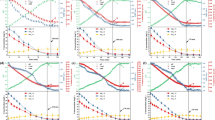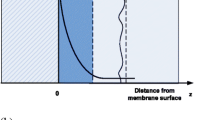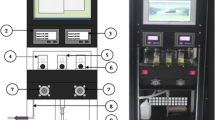Abstract
Online sensors, which monitor the ammonia oxidation and the dissimilatory nitrate reduction process, can optimize aerobic and anoxic phase duration. The purpose of this study was to comparatively evaluate the effectiveness of online sensors that were in situ–located in an intermittently aerated and fed membrane bioreactor (IAF-MBR) system. Ammonium and nitrate nitrogen sensors equipped with ion-selective electrodes as well as pH and oxidation–reduction potential (ORP) sensors were employed to online monitoring and optimizing of ammonia oxidation and nitrate reduction processes. The “ammonia valley” or pH bending point, which is indicative of ammonia depletion, was effectively and repeatedly detected by measuring the pH profile, while the “nitrate knee” point, which indicates the completion of the denitrification process, was online-detected by obtaining the ORP profile. The “ammonia valley” and “nitrate knee” were detected at pH and ORP values of 6.47 ± 0.02 and – 162 ± 39 mV, respectively. The ORP and pH first derivatives (dORP/dt and dpH/dt) were found to be more suitable than the untransformed ORP and pH values in detecting pH and ORP inflection points and controlling the shift from the anoxic to the aeration phase. Specifically, the ORP and pH bending points were detected at dORP/dt and dpH/dt values of 1.64 ± 0.82 mV min−1 and 0.005 ± 0.001 min−1, respectively. Moreover, the ORP first derivative has appeared earlier than the ORP bending point.





Similar content being viewed by others
References
Antileo C, Medina H, Bornhardt C, Muñoz C, Jaramillo F, Proal J (2013) Actuators monitoring system for real-time control of nitrification–denitrification via nitrite on long term operation. Chem Eng J 223:467–478
Azis K, Ntougias S, Melidis P (2019) Evaluation of fouling prevention methods in a submerged membrane bioreactor treating domestic wastewater. Desalin Water Treat 170:415–424
Charpentier J, Martin G, Wacheux H, Gilles P (1998) ORP regulation and activated sludge: 15 years of experience. Water Sci Technol 38:197–208
Claros J, Serralta J, Seco A, Ferrer J, Aguado D (2012) Real-time control strategy for nitrogen removal via nitrite in a SHARON reactor using pH and ORP sensors. Process Biochem 47:1510–1515
Cornelissen R, Van Dyck T, Dries J, Ockier P, Smets I, Van Den Broeck R, Van Hulle S, Feyaerts M (2018) Application of online instrumentation in industrial wastewater treatment plants-a survey in Flanders, Belgium. Water Sci Technol 78:957–967
dos Santos CED, de Bello Solcia Guerrero R, de Godoi LAG, Foresti E, Damianovic MHRZ (2018) Dynamics of the nitrification and sulfide-driven autotrophic denitrification processes in a single reactor using oxidation-reduction potential as an indicator of the process effectiveness. J Chem Technol Biotechnol 93:3483–3491
Fox S, Clifford E (2018) Detecting the end of nitrification in small and decentralized wastewater treatment systems using low-resource real-time control methods. J Environ Eng 144(8):04018069
Ga CH, Ra CS (2009) Real-time control of oxic phase using pH (mV)-time profile in swine wastewater treatment. J Hazard Mater 172:61–67
Gao D, Peng Y, Li B, Liang H (2009) Shortcut nitrification-denitrification by real-time control strategies. Bioresour Technol 100:2298–2300
Guo J, Yang Q, Peng Y, Yang A, Wang S (2007) Biological nitrogen removal with real-time control using step-feed SBR technology. Enzym Microb Technol 40:1564–1569
Hajsardar M, Borghei SM, Hassani AH, Takdastan A (2016) Simultaneous ammonium and nitrate removal by a modified intermittently aerated sequencing batch reactor (SBR) with multiple filling events. Pol J Chem Technol 18:72–80
Han Z, Wu W, Zhu J, Chen Y (2008) Oxidization-reduction potential and pH for optimization of nitrogen removal in a twice-fed sequencing batch reactor treating pig slurry. Biosyst Eng 99:273–281
Kim J, Chen M, Kishida N, Sudo R (2004) Integrated real-time control strategy for nitrogen removal in swine wastewater using sequencing batch reactors. Water Res 38:3340–3348
Li S, Mu J, Du Y, Wu Z (2019) Study and application of real-time control strategy based on DO and ORP in nitritation-denitrification SBR start-up. Environ Technol (United Kingdom) (Published online. https://doi.org/10.1080/09593330.2019.1624297)
López-Palau S, Pinto A, Basset N, Dosta J, Mata-Álvarez J (2012) ORP slope and feast-famine strategy as the basis of the control of a granular sequencing batch reactor treating winery wastewater. Biochem Eng J 68:190–198
Luccarini L, Pulcini D, Sottara D, Di Cosmo R, Canziani R (2017) Monitoring denitrification by means of pH and ORP in continuous-flow conventional activated sludge processes. Desalin Water Treat 61:319–325
Martín de la Vega PT, Martínez de Salazar E, Jaramillo MA, Cros J (2012) New contributions to the ORP & DO time profile characterization to improve biological nutrient removal. Bioresour Technol 114:160–167
Nardelli P, Gatti G, Eusebi AL, Battistoni P, Cecchi F (2009) Full-scale application of the alternating oxic/anoxic process: an overview. Ind Eng Chem Res 48:3526–3532
Peng YZ, Chen Y, Peng CY, Liu M, Wang SY, Song XQ, Cui YW (2004) Nitrite accumulation by aeration controlled in sequencing batch reactors treating domestic wastewater. Water Sci Technol 50:35–43
Ribeiro R, von Atzingen GV, Lima F, Okamoto VHT, Arce AIC, Tomamso G, da Costa EJX (2017) Real-time control system based on the values of derivative of the redox potential aiming nitrogen removal in a sequencing batch reactor applied in treating dairy wastewater. Water Air Soil Pollut 228(7):231
Ruano MV, Ribes J, Seco A, Ferrer J (2012) An advanced control strategy for biological nutrient removal in continuous systems based on pH and ORP sensors. Chem Eng Sci 183:212–221
Shimabukuro M, Yang PY, Kim SJ (2004) Applicability of oxidation reduction potential response on a full-scale intermittently aerated suspended culture system. J Hazard Toxic Radioact Waste 8:19–25
Tanwar P, Nandy T, Ukey P, Manekar P (2008) Correlating on-line monitoring parameters, pH, DO and ORP with nutrient removal in an intermittent cyclic process bioreactor system. Bioresour Technol 99:7630–7635
Wang S, Zhang S, Peng C, Akio T (2008) Intercross real-time control strategy in alternating activated sludge process for short-cut biological nitrogen removal treating domestic wastewater. J Environ Sci 20:957–963
Wang S, Yu J, Wei T, Chi Y, Suna L, Peng Y (2012) Applying real-time control for achieving nitrogen removal via nitrite in a lab-scale CAST system. Environ Technol (United Kingdom) 33(10):1133–1140
Won SG, Ra CS (2011) Biological nitrogen removal with a real-time control strategy using moving slope changes of pH (mV)- and ORP-time profiles. Water Res 45:171–178
Wu Z, Mu J, Liu M, Yu M, Wang Y, Cai M, Li S (2019) The study on real-time control of nitritation SBR based on the first-derivative of DO and ORP. Huanjing Kexue Xuebao 39(5):1544–1553
Yang Q, Peng Y, Liu X, Zeng W, Mino T, Satoh H (2007) Nitrogen removal via nitrite from municipal wastewater at low temperatures using real-time control to optimize nitrifying communities. Environ Sci Technol 41:8159–8164
Zekker I, Kiviruüt A, Rikmann E, Mandel A, Jaagura M, Tenno T, Artemchuk O, Rubin SD, Tenno T (2019) Enhanced efficiency of nitritating-anammox sequencing batch reactor achieved at low decrease rates of oxidation-reduction potential. Environ Eng Sci 36:350–360
Funding
This research is co-financed by Greece and the European Union (European Social Fund-ESF) through the Operational Programme “Human Resources Development, Education and Lifelong Learning” in the context of the project “Strengthening Human Resources Research Potential via Doctorate Research” (MIS-5000432), implemented by the State Scholarships Foundation (ΙΚΥ).
Author information
Authors and Affiliations
Corresponding author
Additional information
Responsible Editor: Angeles Blanco
Publisher’s note
Springer Nature remains neutral with regard to jurisdictional claims in published maps and institutional affiliations.
Rights and permissions
About this article
Cite this article
Azis, K., Ntougias, S. & Melidis, P. NH4+-N versus pH and ORP versus NO3−-N sensors during online monitoring of an intermittently aerated and fed membrane bioreactor. Environ Sci Pollut Res 28, 33837–33843 (2021). https://doi.org/10.1007/s11356-020-10534-4
Received:
Accepted:
Published:
Issue Date:
DOI: https://doi.org/10.1007/s11356-020-10534-4




